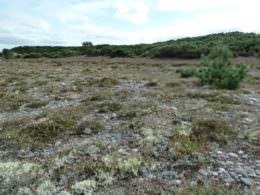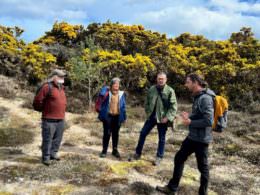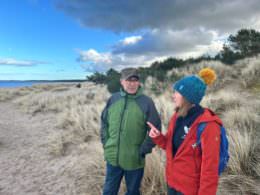Thank you to everyone who donated to the Big Give appeal!
 This enables us to go ahead with the first year of dune restoration work, scheduled for this coming winter. This involves the clearance of around half a hectare of carefully selected gorse, to create new bare sand habitats for rare and threatened sand dune species. It will also help to reintroduce the natural process of windblown sand.
This enables us to go ahead with the first year of dune restoration work, scheduled for this coming winter. This involves the clearance of around half a hectare of carefully selected gorse, to create new bare sand habitats for rare and threatened sand dune species. It will also help to reintroduce the natural process of windblown sand.
We had a very interesting meeting recently with ecologist James Bunyan, of Tracks Ecology, who kindly donated his time by coming over to explain how we might be able to use UAVs (drones) to monitor the ecological impact of the Project. We hope to explore this further, potentially using cutting-edge techniques to monitor the response of rare lichens to our work.
 A public meeting in March, in the Ecovillage, was very well attended. There were presentations from Jonathan Caddy (Chair), Heather Paul (Lichenologist), Alan Watson Featherstone (Land Trustee), and myself. The response was very enthusiastic, with an interesting and helpful discussion, concluded by an enjoyable walk on the land.
A public meeting in March, in the Ecovillage, was very well attended. There were presentations from Jonathan Caddy (Chair), Heather Paul (Lichenologist), Alan Watson Featherstone (Land Trustee), and myself. The response was very enthusiastic, with an interesting and helpful discussion, concluded by an enjoyable walk on the land.
Some of the more frequently asked questions we are asked about the Project, and our replies, include:
Q: Why are you removing the gorse? This is an important habitat too.
A: We are only removing carefully selected areas of gorse, to make maximum biodiversity benefit for extremely rare species and habitats. While gorse is a valuable habitat, it is replacing far more valuable habitats. These habitats support species which are threatened with extinction if action is not taken.
Q: The dunes are rewilding themselves, why do you want to interfere with this natural process?
A: Gorse and tree growth on the dunes is not natural. It is the result of previous human actions – mainly house building and tree planting – which has resulted in reduced wind speeds and plantation tree seeds being blown onto the dunes. This has allowed scrub to spread quickly, so that natural, rare and fragile sand dune habitats and species are now threatened. We aim to open-up the scrub to truly natural, wind-driven, processes, rejuvenating the dune ecosystem. We are carefully targeting our actions to benefit key habitats and species. Gorse and woodland will continue to develop elsewhere on the dunes. We are not alone in undertaking this urgent conservation work. The Royal Society for the Protection of Birds (Europe’s largest nature conservation charity), Forestry and Land Scotland (the government agency responsible for the national forest estate), and the charity Butterfly Conservation all have similar dune restoration projects on the Moray Firth.
Q: What’s the point of doing this work if the gorse is going to take over anyway? It’s a losing battle.
A: National biodiversity interests – lichens and insects – are under threat of extinction. We know what the problem is. We can do something about it. If we don’t the problem will get worse. We are in a world-wide biodiversity crisis and feel that, as custodians of the land, we have a responsibility to protect high priority species and habitats. Increasing the flow of wind through the area will help to slow the spread of gorse and trees. It’s an ongoing issue. We are just starting. But even if we do this project and nothing else, there will be immediate benefits for priority wildlife over the medium term.
Please do keep an eye on our Facebook Page – Findhorn Hinterland Trust – for snippets of information on the importance of the dunes for biodiversity. Recent posts have featured the following Star Species:
- Sandy Earthtongue fungus – found at only two sites in the UK, and plentiful here
- The moth Scythris empetrella – found at only two sites in Scotland, Findhorn Dunes being the most important
- The Felt Lichen – a red Data Book, Endangered and Nationally Rare species, found in relative abundance on the dunes
- The moth Caryocolum blandelloides – new to science as recently as 1981, with a UK range is limited to sand dune systems in the western Moray Firth.
 It was also good to share an article from the Guardian, which describes how nature conservation organisations across the UK are turning their attention to hitherto overlooked rare coastal ‘microhabitats’ – just like the Findhorn dunes: https://www.theguardian.com/uk-news/2024/mar/27/lizard-peninsula-recovery-project-save-microhabitats
It was also good to share an article from the Guardian, which describes how nature conservation organisations across the UK are turning their attention to hitherto overlooked rare coastal ‘microhabitats’ – just like the Findhorn dunes: https://www.theguardian.com/uk-news/2024/mar/27/lizard-peninsula-recovery-project-save-microhabitats
Sean Reed,
Dune Restoration Project

















Dune Restoration Project Update
Thank you to everyone who donated to the Big Give appeal!
We had a very interesting meeting recently with ecologist James Bunyan, of Tracks Ecology, who kindly donated his time by coming over to explain how we might be able to use UAVs (drones) to monitor the ecological impact of the Project. We hope to explore this further, potentially using cutting-edge techniques to monitor the response of rare lichens to our work.
Some of the more frequently asked questions we are asked about the Project, and our replies, include:
Q: Why are you removing the gorse? This is an important habitat too.
A: We are only removing carefully selected areas of gorse, to make maximum biodiversity benefit for extremely rare species and habitats. While gorse is a valuable habitat, it is replacing far more valuable habitats. These habitats support species which are threatened with extinction if action is not taken.
Q: The dunes are rewilding themselves, why do you want to interfere with this natural process?
A: Gorse and tree growth on the dunes is not natural. It is the result of previous human actions – mainly house building and tree planting – which has resulted in reduced wind speeds and plantation tree seeds being blown onto the dunes. This has allowed scrub to spread quickly, so that natural, rare and fragile sand dune habitats and species are now threatened. We aim to open-up the scrub to truly natural, wind-driven, processes, rejuvenating the dune ecosystem. We are carefully targeting our actions to benefit key habitats and species. Gorse and woodland will continue to develop elsewhere on the dunes. We are not alone in undertaking this urgent conservation work. The Royal Society for the Protection of Birds (Europe’s largest nature conservation charity), Forestry and Land Scotland (the government agency responsible for the national forest estate), and the charity Butterfly Conservation all have similar dune restoration projects on the Moray Firth.
Q: What’s the point of doing this work if the gorse is going to take over anyway? It’s a losing battle.
A: National biodiversity interests – lichens and insects – are under threat of extinction. We know what the problem is. We can do something about it. If we don’t the problem will get worse. We are in a world-wide biodiversity crisis and feel that, as custodians of the land, we have a responsibility to protect high priority species and habitats. Increasing the flow of wind through the area will help to slow the spread of gorse and trees. It’s an ongoing issue. We are just starting. But even if we do this project and nothing else, there will be immediate benefits for priority wildlife over the medium term.
Please do keep an eye on our Facebook Page – Findhorn Hinterland Trust – for snippets of information on the importance of the dunes for biodiversity. Recent posts have featured the following Star Species:
Sean Reed,
Dune Restoration Project